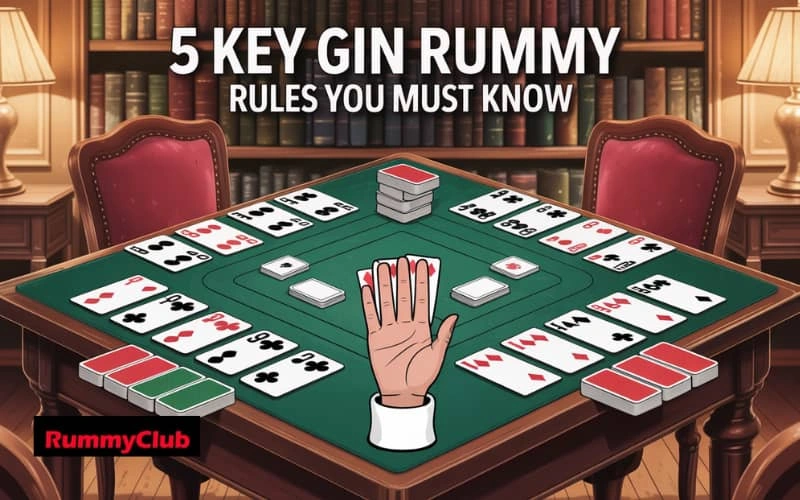Gin Rummy is one of the most popular and strategic card games played around the world. It is a two-player version of Rummy and combines skill, memory, and a bit of luck. If you are new to the game or looking to improve your gameplay, understanding the essential gin rummy rules is critical rummy plus club. This guide covers the five key gin rummy rules you must know to play effectively and confidently.
Objective of the Game
The main goal in Gin Rummy is to form sets and runs from the cards in your hand. A set consists of three or four cards of the same rank but different suits, while a run consists of three or more cards of the same suit in consecutive order. The player who can arrange their cards into valid combinations and reduce the number of unmatched cards, or deadwood, is in a better position to win.
Understanding this objective is one of the basic gin rummy rules that lays the foundation for more advanced strategies. Each round continues until a player can knock, go gin, or the stockpile runs out.
Rule 1: The Deal and Setup
The game starts with a standard 52-card deck. Each player is dealt ten cards. The remaining cards form the stockpile and are placed face down in the center. One card is placed face up beside the stockpile to begin the discard pile.
The non-dealer gets the first option to take the face-up card. If they decline, the dealer gets the option. If both decline, the game begins with the non-dealer drawing the top card from the stockpile.
This is one of the key gin rummy rules that affects the initial strategy. Choosing whether to pick the face-up card can provide early insight into your opponent’s strategy and can even give you a quick advantage.
Rule 2: Drawing and Discarding
Players take turns drawing one card and discarding one card. On their turn, a player can draw either the top card from the stockpile or the top card from the discard pile. After drawing, they must discard one card from their hand.
This part of the game continues in turns. Observing this rule helps manage your hand while also giving clues to what your opponent is collecting. If they consistently draw from the discard pile, you might guess what type of cards they are aiming for.
Understanding how and when to draw and discard is one of the most crucial gin rummy rules. Good players not only improve their own hand but also avoid giving their opponent useful cards through discards.
Rule 3: Knocking
A player can end the round by knocking if the total value of their deadwood cards is 10 or less. When knocking, the player places their final card face down on the discard pile and reveals their hand. The opponent also reveals their hand and may lay off their unmatched cards by adding them to the knocker’s sets or runs.
The values of face cards are 10 points, aces are worth 1 point, and all other cards have their face value. Reducing deadwood efficiently and recognizing the right time to knock are essential gin rummy rules that impact scoring and momentum.
If the knocker has less deadwood than their opponent, they score the difference in points. If the opponent has less or equal deadwood, it results in an undercut and the opponent gets a bonus.
Rule 4: Going Gin
Going gin is one of the most rewarding moves in the game. A player can go gin when all ten cards form valid sets or runs and no deadwood remains. The player places the final card face down and reveals the hand.
The opponent cannot lay off any cards when a player goes gin. This rule provides a big scoring advantage as the player scores 25 bonus points plus the opponent’s total deadwood.
Going gin requires skill and planning. Holding out for a gin hand is risky, but it is one of the gin rummy rules that can quickly turn the game in your favor if executed successfully.

Rule 5: Scoring and Winning
Scoring is an essential part of understanding gin rummy rules. After each round, the winner scores the value of the opponent’s deadwood minus their own. A bonus is added for going gin or winning by undercut.
The game usually continues until one player reaches a set score, commonly 100 points. An additional game bonus is often awarded to the overall winner, with extra bonuses for each gin and undercut along the way.
Tallying up the points accurately and strategically choosing when to knock, go gin, or continue playing are vital parts of mastering the scoring rules in gin rummy.
Tips for Applying Gin Rummy Rules Strategically
Applying gin rummy rules effectively can give you a strong edge. Watch the discard pile closely to determine what your opponent might be collecting. Avoid discarding cards that could complete their melds. Keep your own hand flexible by aiming for multiple possible combinations.
Know when to knock and when to hold out for gin. If your deadwood is low, it may be wise to knock rather than risk your opponent going gin. On the other hand, if you are confident in your combinations, waiting for gin can result in a high-scoring round.
Keep track of the cards played and try to calculate which cards are still in the deck. This card tracking is one of the subtle yet powerful strategies in line with the core gin rummy rules.
Conclusion
Mastering the five key gin rummy rules can make a huge difference in your gameplay. From understanding how to draw and discard to knowing when to knock or go gin, every rule serves as a stepping stone to becoming a more skilled and strategic player. Whether you are just beginning or refining your skills, sticking to these essential gin rummy rules will enhance your chances of winning and enjoying this classic card game to the fullest.


